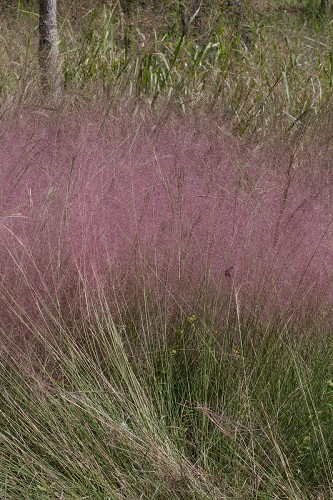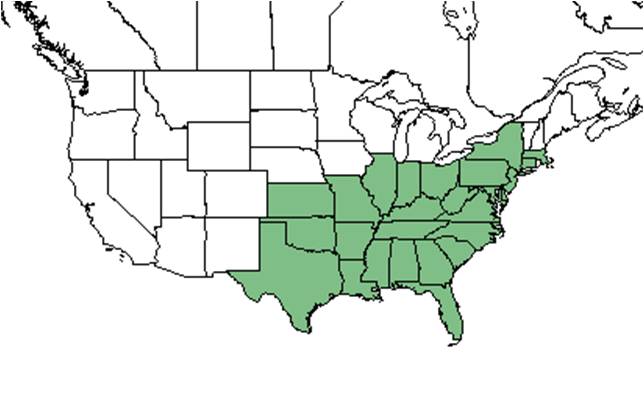Difference between revisions of "Muhlenbergia capillaris"
| (36 intermediate revisions by 14 users not shown) | |||
| Line 3: | Line 3: | ||
{{taxobox | {{taxobox | ||
| name = Muhlenbergia capillaris | | name = Muhlenbergia capillaris | ||
| − | | image = | + | | image = Muhl_capi.jpg |
| − | | image_caption = | + | | image_caption = Photo by John R. Gwaltney, [http://www.southeasternflora.com/index.asp Southeastern Flora.com] |
| regnum = Plantae | | regnum = Plantae | ||
| divisio = Tracheophyta- Vascular plants | | divisio = Tracheophyta- Vascular plants | ||
| Line 15: | Line 15: | ||
| binomial_authority = (Lam.) Trin. | | binomial_authority = (Lam.) Trin. | ||
| range_map = muhl_capi_dist.jpg | | range_map = muhl_capi_dist.jpg | ||
| − | | range_map_caption = Natural range of ''Muhlenbergia capillaris'' from USDA NRCS [http:// | + | | range_map_caption = Natural range of ''Muhlenbergia capillaris'' from USDA NRCS [http://plants.usda.gov/core/profile?symbol=MUCA2 Plants Database]. |
}} | }} | ||
| + | |||
| + | Common names: hairgrass, hair-awm muhly<ref name=weakley>Weakley, A.S. 2020. Flora of the Southeastern United States. Edition of 20 October 2020. University of North Carolina at Chapel Hill, Chapel Hill, North Carolina.</ref> | ||
| + | ==Taxonomic notes== | ||
| + | Synonyms: ''Muhlenbergia capillaris'' var. ''capillaris''<ref name=weakley/> | ||
| + | |||
| + | Varieties: none<ref name=weakley/> | ||
| + | |||
==Description== | ==Description== | ||
<!-- Basic life history facts such as annual/perrenial, monoecious/dioecious, root morphology, seed type, etc. --> | <!-- Basic life history facts such as annual/perrenial, monoecious/dioecious, root morphology, seed type, etc. --> | ||
| − | + | "Perennials. Blades usually scaberulous on both surfaces and margins; sheath margins scarious, at least apically; ligules scarious, erose or erose-ciliate. Spikelets 1-flowered. Glumes equaling or shorter than lemmas, lemmas not indurate. Grain enclosed by lemma and palea at maturity."<ref name="Radford et al 1964">Radford, Albert E., Harry E. Ahles, and C. Ritchie Bell. Manual of the Vascular Flora of the Carolinas. 1964, 1968. The University of North Carolina Press. 107. Print.</ref> | |
| + | |||
| + | "Cespitose perennial; culms 5-12 dm tall, nodes and internodes glabrous. Leaves primarily basal; blades flat or involute, to 3 dm long, 103 mm wide; sheaths scaberulous; ligules 2-5 mm long. Panicle open, diffuse, delicate, 2-5 dm long, 1-2 dm broad; branches capillary, spreading, scaberulous. Spikelets usually purplish, lanceolate to narrowly ellipsoid, 4-5 mm long excluding awn; pedicels capillary, spreading, scaberulous. Glumes usually 1-nerved, usually scaberulous on midrib, scarious, 1st glume body 0.3-1.2 mm long, awn 0.3-1.2 mm long, 2nd glume body 1-1.5 mm long, awn 1-1.5 mm long; lemmas purplish, 3-nerved, scaberulous, body 3-4 mm long, awns 3-12 mm long; paleas purplish, faintly nerved, acuminate, 3-4 mm long. Grain purplish, narrowly ellipsoid, 2-2.4 mm long."<ref name="Radford et al 1964"/> | ||
==Distribution== | ==Distribution== | ||
| + | ''M. capillaris'' ranges from Massachusetts, New York, southern Ohio southern Indiana, southern Illinois, Missouri, and eastern Kansas to southern Florida, Louisiana, and southern Texas.<ref name=weakley/> | ||
| + | |||
==Ecology== | ==Ecology== | ||
| − | ===Habitat=== <!--Natural communities, human disturbed habitats, topography, hydrology, soils, light, fire regime requirements for removal of competition, etc.--> | + | ===Habitat===<!--Natural communities, human disturbed habitats, topography, hydrology, soils, light, fire regime requirements for removal of competition, etc.--> |
| + | ''M. capillaris'' has been found in marshes, open pineland, pine-turkey oak flats, drained buttonwood flats, sandy ridges, limerock, slash pineland, treeless chalk glades, and dike crests.<ref name="FSU"> Florida State University Herbarium Database. URL: http://herbarium.bio.fsu.edu. Last accessed: June 2021. Collectors: Loran C. Anderson, Wilson Baker,A. F. Clewell, Mark A Garland, R.K. Godfrey, Ed Keppner, Lisa Keppner, R. Kral, and O. Lakela. States and counties: Florida: Bay, Franklin, Gadsden, Hillsborough, Leon, Madison, Monroe, Nassau and Wakulla.</ref> It is also found in disturbed areas including cleared construction sites, powerline corridors, roadsides, burned slash pine-scrub flats, and disturbed longleaf pinelands.<ref name="FSU"/> Associated species: ''Sporobolus junceus, Dichanthelium dichotomum, Rudbeckia flugida, Schizachyrium scoparium, Pyracantha, Sideroxylon'', and ''Berchemia''.<ref name="FSU"/> | ||
| + | |||
| + | ''M. capillaris'' decreased its occurrence in response to soil disturbance by agriculture in southwest Georgia. It has shown resistance to regrowth in reestablished savanna habitats that were disturbed by these practices.<ref>Kirkman, L.K., K.L. Coffey, R.J. Mitchell, and E.B. Moser. Ground Cover Recovery Patterns and Life-History Traits: Implications for Restoration Obstacles and Opportunities in a Species-Rich Savanna. (2004). Journal of Ecology 92(3):409-421.</ref><ref>Ostertag, T. E. and K. M. Robertson. 2007. A comparison of native versus old-field vegetation in upland pinelands managed with frequent fire, South Georgia, USA. Tall Timbers Fire Ecology Conference Proceedings 23: 109-120.</ref> It was found to have mixed responses to soil disturbance by roller chopping in south Florida. It either exhibits regrowth or its growth is unaffected in reestablished, post-disturbance habitat.<ref>Lewis, C.E. (1970). Responses to Chopping and Rock Phosphate on South Florida Ranges. Journal of Range Management 23(4):276-282.</ref> | ||
| + | |||
| + | ''Muhlenbergia capillaris'' var. ''trichopodes'' is frequent and abundant in the Clayhill Longleaf Woodlands and Lower Panhandle Savannas community types as described in Carr et al. (2010).<ref>Carr, S.C., K.M. Robertson, and R.K. Peet. 2010. A vegetation classification of fire-dependent pinelands of Florida. Castanea 75:153-189.</ref> | ||
===Phenology=== <!--Timing off flowering, fruiting, seed dispersal, and environmental triggers. Cite PanFlora website if appropriate: http://www.gilnelson.com/PanFlora/ --> | ===Phenology=== <!--Timing off flowering, fruiting, seed dispersal, and environmental triggers. Cite PanFlora website if appropriate: http://www.gilnelson.com/PanFlora/ --> | ||
| + | ''M. capillaris'' flowers from late August to October.<ref name=weakley/> | ||
| + | |||
===Seed dispersal=== | ===Seed dispersal=== | ||
| − | ===Seed bank and germination=== | + | This species is thought to be dispersed by gravity.<ref>Kirkman, L. Katherine. Unpublished database of seed dispersal mode of plants found in Coastal Plain longleaf pine-grasslands of the Jones Ecological Research Center, Georgia.</ref> |
| + | <!--===Seed bank and germination===--> | ||
| + | |||
===Fire ecology=== <!--Fire tolerance, fire dependence, adaptive fire responses--> | ===Fire ecology=== <!--Fire tolerance, fire dependence, adaptive fire responses--> | ||
| − | ===Pollination=== | + | Populations of ''Muhlenbergia capillaris'' have been known to persist through repeated annual burns.<ref>Robertson, K.M. Unpublished data collected from Pebble Hill Fire Plots, Pebble Hill Plantation, Thomasville, Georgia.</ref> |
| + | <!--===Pollination===--> | ||
| + | <!--===Herbivory and toxicology===--> <!--Common herbivores, granivory, insect hosting, poisonous chemicals, allelopathy, etc.--> | ||
| + | <!--===Diseases and parasites===--> | ||
| + | |||
| + | ==Conservation, cultivation, and restoration== | ||
| − | == | + | ==Cultural use== |
| − | |||
| − | |||
| − | |||
==Photo Gallery== | ==Photo Gallery== | ||
| + | <gallery widths=180px> | ||
| + | </gallery> | ||
==References and notes== | ==References and notes== | ||
Latest revision as of 14:40, 16 June 2023
| Muhlenbergia capillaris | |
|---|---|

| |
| Photo by John R. Gwaltney, Southeastern Flora.com | |
| Scientific classification | |
| Kingdom: | Plantae |
| Division: | Tracheophyta- Vascular plants |
| Class: | Lilianeae -Monocotyledons |
| Order: | Poales |
| Family: | Poaceae |
| Genus: | Muhlenbergia |
| Species: | M. capillaris |
| Binomial name | |
| Muhlenbergia capillaris (Lam.) Trin. | |

| |
| Natural range of Muhlenbergia capillaris from USDA NRCS Plants Database. | |
Common names: hairgrass, hair-awm muhly[1]
Contents
Taxonomic notes
Synonyms: Muhlenbergia capillaris var. capillaris[1]
Varieties: none[1]
Description
"Perennials. Blades usually scaberulous on both surfaces and margins; sheath margins scarious, at least apically; ligules scarious, erose or erose-ciliate. Spikelets 1-flowered. Glumes equaling or shorter than lemmas, lemmas not indurate. Grain enclosed by lemma and palea at maturity."[2]
"Cespitose perennial; culms 5-12 dm tall, nodes and internodes glabrous. Leaves primarily basal; blades flat or involute, to 3 dm long, 103 mm wide; sheaths scaberulous; ligules 2-5 mm long. Panicle open, diffuse, delicate, 2-5 dm long, 1-2 dm broad; branches capillary, spreading, scaberulous. Spikelets usually purplish, lanceolate to narrowly ellipsoid, 4-5 mm long excluding awn; pedicels capillary, spreading, scaberulous. Glumes usually 1-nerved, usually scaberulous on midrib, scarious, 1st glume body 0.3-1.2 mm long, awn 0.3-1.2 mm long, 2nd glume body 1-1.5 mm long, awn 1-1.5 mm long; lemmas purplish, 3-nerved, scaberulous, body 3-4 mm long, awns 3-12 mm long; paleas purplish, faintly nerved, acuminate, 3-4 mm long. Grain purplish, narrowly ellipsoid, 2-2.4 mm long."[2]
Distribution
M. capillaris ranges from Massachusetts, New York, southern Ohio southern Indiana, southern Illinois, Missouri, and eastern Kansas to southern Florida, Louisiana, and southern Texas.[1]
Ecology
Habitat
M. capillaris has been found in marshes, open pineland, pine-turkey oak flats, drained buttonwood flats, sandy ridges, limerock, slash pineland, treeless chalk glades, and dike crests.[3] It is also found in disturbed areas including cleared construction sites, powerline corridors, roadsides, burned slash pine-scrub flats, and disturbed longleaf pinelands.[3] Associated species: Sporobolus junceus, Dichanthelium dichotomum, Rudbeckia flugida, Schizachyrium scoparium, Pyracantha, Sideroxylon, and Berchemia.[3]
M. capillaris decreased its occurrence in response to soil disturbance by agriculture in southwest Georgia. It has shown resistance to regrowth in reestablished savanna habitats that were disturbed by these practices.[4][5] It was found to have mixed responses to soil disturbance by roller chopping in south Florida. It either exhibits regrowth or its growth is unaffected in reestablished, post-disturbance habitat.[6]
Muhlenbergia capillaris var. trichopodes is frequent and abundant in the Clayhill Longleaf Woodlands and Lower Panhandle Savannas community types as described in Carr et al. (2010).[7]
Phenology
M. capillaris flowers from late August to October.[1]
Seed dispersal
This species is thought to be dispersed by gravity.[8]
Fire ecology
Populations of Muhlenbergia capillaris have been known to persist through repeated annual burns.[9]
Conservation, cultivation, and restoration
Cultural use
Photo Gallery
References and notes
- ↑ 1.0 1.1 1.2 1.3 1.4 Weakley, A.S. 2020. Flora of the Southeastern United States. Edition of 20 October 2020. University of North Carolina at Chapel Hill, Chapel Hill, North Carolina.
- ↑ 2.0 2.1 Radford, Albert E., Harry E. Ahles, and C. Ritchie Bell. Manual of the Vascular Flora of the Carolinas. 1964, 1968. The University of North Carolina Press. 107. Print.
- ↑ 3.0 3.1 3.2 Florida State University Herbarium Database. URL: http://herbarium.bio.fsu.edu. Last accessed: June 2021. Collectors: Loran C. Anderson, Wilson Baker,A. F. Clewell, Mark A Garland, R.K. Godfrey, Ed Keppner, Lisa Keppner, R. Kral, and O. Lakela. States and counties: Florida: Bay, Franklin, Gadsden, Hillsborough, Leon, Madison, Monroe, Nassau and Wakulla.
- ↑ Kirkman, L.K., K.L. Coffey, R.J. Mitchell, and E.B. Moser. Ground Cover Recovery Patterns and Life-History Traits: Implications for Restoration Obstacles and Opportunities in a Species-Rich Savanna. (2004). Journal of Ecology 92(3):409-421.
- ↑ Ostertag, T. E. and K. M. Robertson. 2007. A comparison of native versus old-field vegetation in upland pinelands managed with frequent fire, South Georgia, USA. Tall Timbers Fire Ecology Conference Proceedings 23: 109-120.
- ↑ Lewis, C.E. (1970). Responses to Chopping and Rock Phosphate on South Florida Ranges. Journal of Range Management 23(4):276-282.
- ↑ Carr, S.C., K.M. Robertson, and R.K. Peet. 2010. A vegetation classification of fire-dependent pinelands of Florida. Castanea 75:153-189.
- ↑ Kirkman, L. Katherine. Unpublished database of seed dispersal mode of plants found in Coastal Plain longleaf pine-grasslands of the Jones Ecological Research Center, Georgia.
- ↑ Robertson, K.M. Unpublished data collected from Pebble Hill Fire Plots, Pebble Hill Plantation, Thomasville, Georgia.